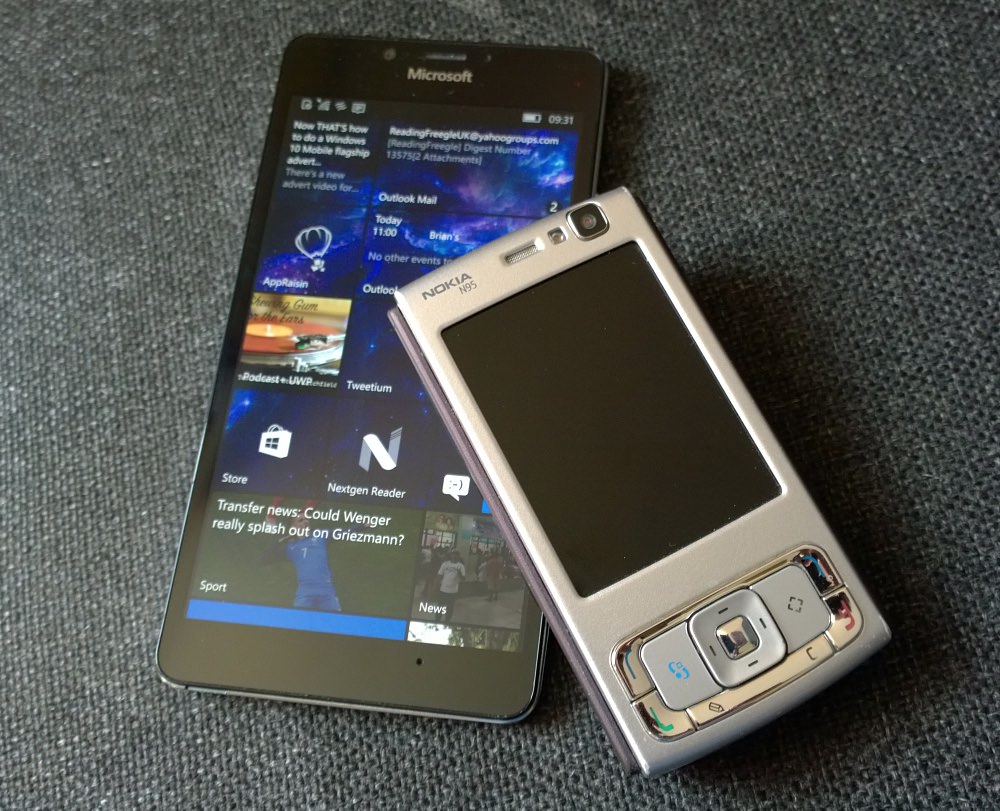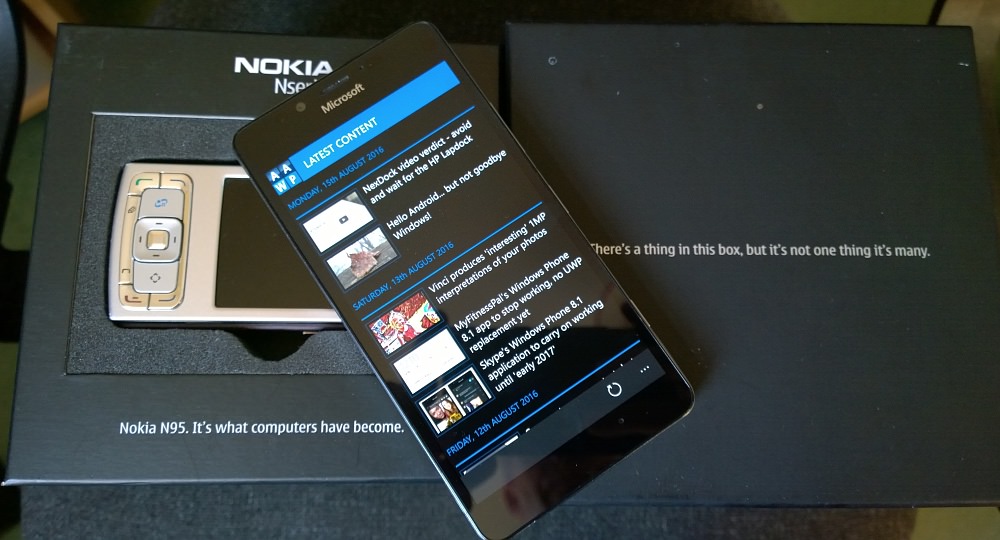I still have the presentation box for that first Nokia N95 (from WOM World, as it was then), with the slogan on the top 'There's a thing in this box. But it's not one thing, it's many.' The idea of the Nokia N95 was that it was the first smartphone to really encompass all the emerging portable tech in one small gadget. High spec 1/2.5"-sensored 5MP camera, GPS, loud stereo speakers, and so on.
Now, technology has moved on in the intervening decade and the N95's feature set is now commonplace - in fact, it's de rigeuer and exceeded in even budget phones in 2016. But the Lumia 950 gives me something of the same impresison. That of one smartphone that can do everything. OK, apart from most of the Google services. And Snapchat. And Pokemon Go. But again, bear with me.

Here then are the main factors that make the Lumia 950 remind me of that original N95, a tech classic in its own right. Might the list also cause you to re-examine the 950 in a new light?
- Materials
Both are unashamedly plastic. I know the current fashion is for aluminium, but plastic has its advantages too - it can be formed into any shape, it's cheaper, it absorbs impacts much better and it's fully transparent to radio signals, so that's better reception for GPS, cellular and Wi-fi and the possibility of Qi wireless charging.
- Flexibility
Now, back in the day it taken for granted that every phone had a battery you could get at, replace, swap out, etc. Ditto a memory card that could be inserted and swapped. The iPhone, arriving shortly after the N95, changed the industry's thinking and now most smartphones arrive with a battery sealed inside and many also have non-expandable internal storage. Sadly. Like the N95, the Lumia 950 has a replaceable battery, plus you can put in as much storage as you like via microSD.
- Best kept secret
Now, I know what you're going to say - the Nokia N95 sold in the millions across the world. But only over a couple of years - it was very expensive for its day - and even then only as part of a very small smartphone scene (less than 20% of all phone sales were smartphones then). And if you cut out the majority of N95 owners who bought it because it was the new tech on the block then you're left with an enthusiast tech community of fans who knew the device was the pinnacle of convergence and used the heck out of it. Now with the Lumia 950 and Windows 10 Mobile, with seemingly miniscule (5% or so even in main markets) market and mind share, so again we have something in your hand that makes you stand out from the crowd, the populace with their mass of iPhones and Android devices.
- Best camera phone in the world
It really was. Back in the day - early 2007 - the Nokia N95's large 1/2.5" 5MP sensor ruled the imaging world. For phone-shot images, at least - we were still a long way from DSLR quality. The N95 was streets ahead of everything, I'd argue, with only a couple of souped up, imaging-centric feature phones as competition. And now in 2016 we have the Lumia 950 as - demonstrably - the best camera phone in the world, beating off the Samsung Galaxy S7 and iPhone 6s/SE.
- Pricey at first but came down fast, similar at each stage
This is true of most new tech, but the Lumia 950 and Nokia N95 both typefied the trend, with prices that were arguably 25% too high at launch and then were down to the 'right' price around six months afterwards. And with monetary values which were nigh-on identical. Which means that the Lumia 950 can now be picked up for under £300 new and SIM-free.
- Buggy and crippled but fixed up in software within six months
Yes, yet another huge similarity - the original N95 was almost unusable - I had one of the first off the factory floor and the first v10 and v11 firmware was appalling. Yet v12 fixed things up acceptably and I seem to remember v20 firmware introducing 'demand paging', i.e. not all of every running application had to be in RAM all the time - this meant an increase in the free RAM after booting from about 20MB to 30MB - a massive jump. The Lumia 950 similarly arrived incomplete, with the OS in something of a state and evidently unfinished, yet with the Redstone update about to hit production devices we've got something much more capable and polished all round.
- Up against the iPhone!
And a world full of Androids now too. The original Nokia N95 was pitched, within six months of launch, into a head on battle against the Apple iPhone. The latter arrived ridiculously immature and under-featured, yet the futuristic vision of the 'Internet in your pocket' and an all-touch interface was something that proved sustainable in the long term, while all the N95's massive feature set gradually got merged into the iPhone range - by the time of the iPhone 4S we'd effectively reached parity. And here we are in 2016 with the Lumia 950 still facing the Apple iPhone as its nemesis, this time the iPhone 6s. And about two billion Android smartphones too, of course - Android hadn't even been dreamt up when the N95 was launched.
- The '95' factor
And I can't ignore the most trivial but obvious similarity that both models have the number sequence '95'. The '9' series always signified the top of the range in the Nokia world and this has carried over into the Microsoft naming. Heck even the Lumia 1020 is really the Nokia 909 - did you know that? Check the various internal 'about' screens!
Comments welcome then. Is it just me making this sort of 'classic' comparison?

